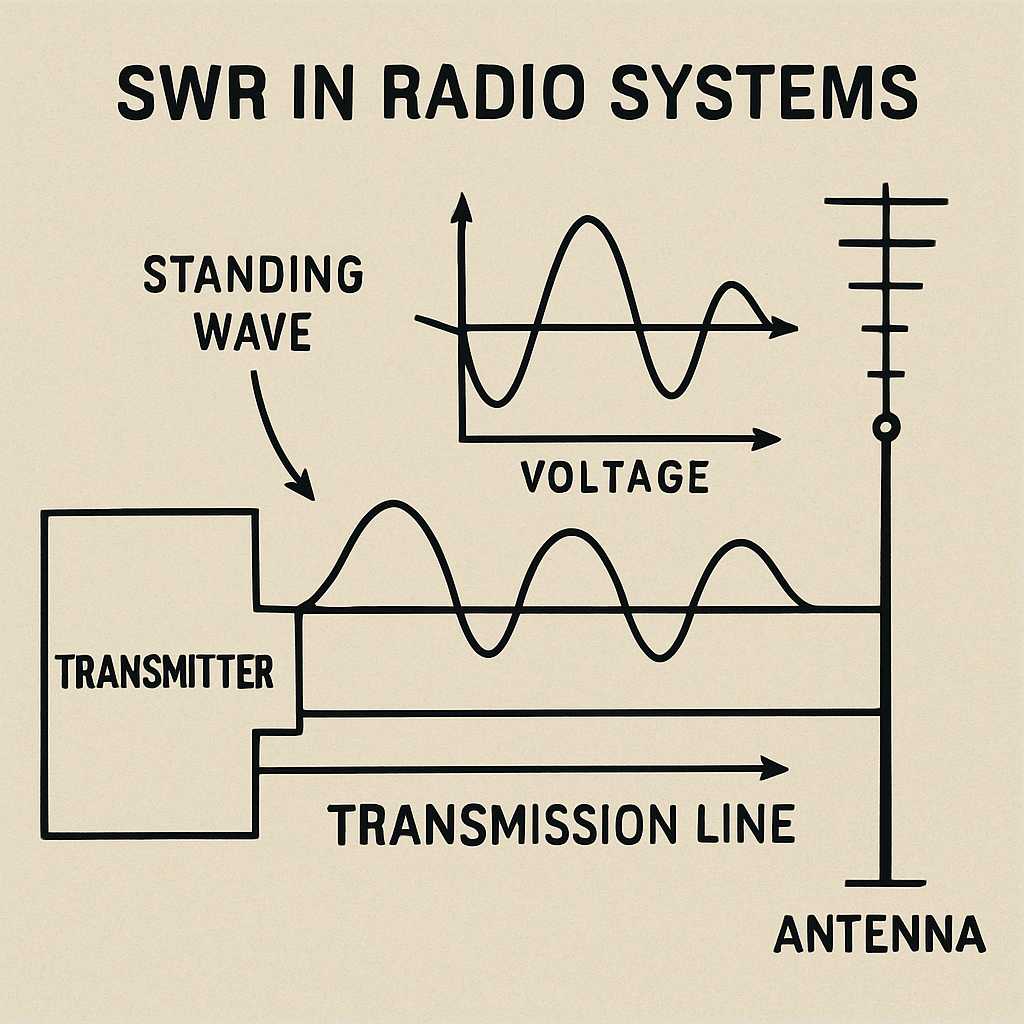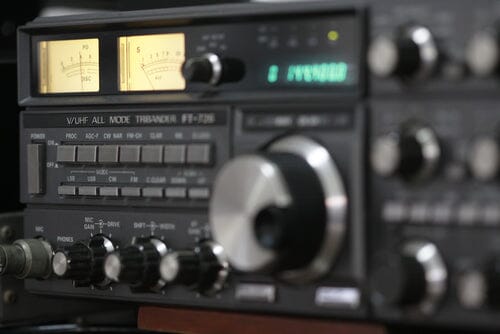Why SWR matters when i comes to Radios
Standing Wave Ratio, or SWR, is a crucial concept in radio communication. It measures how well your radio's power is transmitted through the antenna.
A low SWR means efficient power transfer, leading to better performance. High SWR, however, can cause signal loss and even damage your radio equipment.
Understanding SWR is essential for anyone using radios, from hobbyists to professionals. It ensures your radio operates at its best, providing clear and reliable communication.
SWR measurement is a key part of maintaining your radio system. It involves checking the impedance match between the radio and the antenna.
Tools like SWR meters and calculators help in this process. They provide readings that guide you in making necessary adjustments.
SWR tuning is the process of optimizing these readings. It often involves adjusting the antenna or using a tuner to achieve the best results.
CB radios with built-in SWR meters simplify this task. They allow for easy monitoring and adjustment, ensuring optimal performance.
In this guide, we'll explore why SWR matters and how to manage it effectively.
What is SWR and Why Does it Matter?
SWR stands for Standing Wave Ratio. It's a measure used in radio communication to evaluate the efficiency of power transfer from the radio to the antenna.
Why SWR matters when i comes to Radios
Standing Wave Ratio, or SWR, is a crucial concept in radio communication. It measures how well your radio's power is transmitted through the antenna.
A low SWR means efficient power transfer, leading to better performance. High SWR, however, can cause signal loss and even damage your radio equipment.
Understanding SWR is essential for anyone using radios, from hobbyists to professionals. It ensures your radio operates at its best, providing clear and reliable communication.
SWR measurement is a key part of maintaining your radio system. It involves checking the impedance match between the radio and the antenna.
Tools like SWR meters and calculators help in this process. They provide readings that guide you in making necessary adjustments.
SWR tuning is the process of optimizing these readings. It often involves adjusting the antenna or using a tuner to achieve the best results.
CB radios with built-in SWR meters simplify this task. They allow for easy monitoring and adjustment, ensuring optimal performance.
In this guide, we'll explore why SWR matters and how to manage it effectively.
What is SWR and Why Does it Matter?
SWR stands for Standing Wave Ratio. It's a measure used in radio communication to evaluate the efficiency of power transfer from the radio to the antenna.
When the impedance between the radio and its antenna matches perfectly, power flows smoothly. This optimal condition results in a low SWR reading.
A high SWR indicates poor impedance matching. This mismatch means some of the power is reflected back to the radio, not transmitted.
Reflected power can lead to several problems. It can reduce the range and clarity of your communications.
The excess reflected power can also damage your radio over time. This makes regular SWR checks essential for maintaining equipment health.
Understanding SWR is vital for both amateur and professional radio users. It ensures your system operates efficiently, prolonging equipment life.
In summary, SWR matters because it affects the performance and durability of your radio equipment. Key considerations include:
- Ensuring efficient power transfer from radio to antenna
- Protecting equipment from damage due to high SWR
- Optimizing communication clarity and reach
Awareness of SWR helps troubleshoot performance issues. It allows you to make necessary adjustments for better communication.
Every radio enthusiast should grasp SWR basics. It’s the foundation of optimal radio performance and efficient communication.
The Science Behind SWR: How It Works in Radios
SWR or Standing Wave Ratio is fundamental to radio communication. It measures the degree of impedance matching between your radio and antenna.
Impedance is like a gatekeeper for signals. Proper matching means signals pass through easily.
Poor matching leads to signal reflection, where some power bounces back to the radio instead of being transmitted. This is where SWR comes into play, indicating how much of this reflection occurs.
The concept involves a few essential components:
- Impedance Matching: Ensures seamless power transmission.
- Wave Reflection: Occurs if the match isn’t perfect, leading to losses.
- Power Efficiency: Low SWR means higher efficiency and better power use.
A perfect impedance match results in an SWR of 1:1. This indicates no reflected power, which is ideal.
Radio systems with a high SWR encounter inefficiency. High SWR, such as 3:1, shows significant reflection, limiting effective power reach.
Understanding the science behind SWR helps radio users make informed adjustments. It ensures devices operate at peak performance.
With better SWR, radio signals travel further and clearer. This impacts users' ability to communicate effectively.
SWR underscores a crucial scientific principle: efficiency through balance. Keeping a balanced impedance ensures optimal system functionality. For radio enthusiasts, mastering SWR enhances both their technical knowledge and their radio experience.
Effects of High and Low SWR on Radio Performance
Understanding SWR impacts radio efficiency directly. High SWR can severely affect radio performance.
A high SWR ratio signifies impedance mismatch. This results in more power reflecting back into the radio instead of being transmitted through the antenna.
by YearOne (https://unsplash.com/@year1)
Excessive reflected power risks damaging radio components. It could overheat or shorten the lifespan of the radio.
Conversely, a low SWR indicates good impedance matching. This means more of your signal is effectively transmitted.
The benefits of maintaining a low SWR include:
- Increased Range: Signals can travel further.
- Clearer Communication: Reduces signal distortion.
- Less Wear on Equipment: Protects your radio from damage.
A keen focus on SWR can prevent many common radio problems. By measuring and adjusting SWR, users ensure peak functionality.
Ignoring high SWR might compromise radio systems. Users can miss crucial communications due to weak or unclear signals.
Both high and low SWR serve as performance indicators. Understanding these effects guides users toward optimal radio operation.
Regular SWR maintenance can lead to better signal clarity and longevity of equipment. The importance of balancing SWR lies in ensuring effective radio communications.
SWR Measurement: Tools and Techniques
Accurate SWR measurement is essential for maintaining radio performance. The right tools make this process simpler.
An SWR meter is a primary tool used for measuring the standing wave ratio in radios. It connects between the transmitter and the antenna.

The meter measures both forward and reflected power. From these measurements, it calculates SWR values.
These readings help identify if adjustments are necessary. A low SWR ensures your radio setup is transmitting efficiently.
There are various SWR meters available. Options range from basic to advanced models with additional features.
Common tools and techniques for SWR measurement include:
- SWR Meters: Basic devices for straightforward measurements.
- Antenna Analyzers: Offer detailed information about antenna performance.
- Digital SWR Meters: Provide precise, easily readable measurements.
SWR measurement technique involves tuning the radio to a set frequency. Then, the user transmits briefly and observes the meter reading.
When measuring, always begin with a low-power transmission. This prevents potential damage if SWR levels are high.
Regular measurement identifies SWR changes. It can indicate issues with antenna connections or environmental factors affecting transmission.

It's important to ensure all cables are secure during the measurement. Loose connections can lead to inaccurate readings.
Tools like online SWR calculators can aid measurement. They simplify the process by estimating SWR based on power inputs.
In summary, proper tools and correct techniques are vital. Consistent SWR measurements contribute significantly to radio effectiveness and longevity.
Understanding SWR Readings: What the Numbers Mean
SWR readings provide crucial insights into your radio system's health. They indicate how efficiently your setup is operating.
A perfect SWR reading would be 1:1. This means the transmitter's power is entirely carried to the antenna with no reflection.

In reality, achieving exactly 1:1 is rare. A reading close to 1.5:1 is generally acceptable for most radio systems.
Higher readings suggest power loss. This can cause overheating and potentially damage the radio equipment.
Here's a breakdown of what different SWR readings imply:
- 1.0 - 1.5: Excellent, efficient power transfer.
- 1.6 - 2.0: Acceptable, but room for improvement.
- Above 2.0: Needs attention; risk of damage increases.
SWR readings guide you in making necessary adjustments. They can indicate if the antenna needs tuning or any other modification.
Understanding these numbers helps ensure your radio performs optimally. Regular checks allow you to spot problems early.
Never ignore high SWR readings. They are a sign that adjustments or repairs are required.
Incorporating frequent SWR checks into your routine ensures reliable communication. It also prolongs the lifespan of your equipment.
SWR Tuning: Step-by-Step Guide to Achieving Optimal SWR
Tuning your radio for optimal SWR is essential. It ensures the best performance and prevents equipment damage.
To begin, you'll need the right tools. An SWR meter is a must-have for accurate measurements.

First, connect the SWR meter between your radio and antenna. This setup allows you to read SWR levels directly.
Next, power on your radio. Make sure you're on a clear frequency with minimal interference.
Transmitting briefly will help gauge initial SWR readings. Monitor the meter carefully as you transmit.
If your SWR is higher than 1.5:1, adjustments are needed. Start by changing the antenna's length or position.
- Shorten or lengthen the antenna slightly.
- Recheck the SWR reading.
- Repeat until the reading improves.
Tuning the antenna might also be necessary. Adjust its height or orientation for better results.
Continue to make small changes and monitor the effects. Precision is key to achieving optimal SWR levels.

If the SWR doesn't improve, check all connections. Loose cables or faulty equipment can affect readings.
Through diligent testing and adjusting, you can achieve the lowest possible SWR. This enhances your radio’s efficiency and reach.
Finally, document your findings. Regular maintenance based on these records prevents future issues.
Mastering SWR tuning offers immense benefits. It's crucial for anyone who relies on consistent radio communication.
Antenna SWR: Factors That Affect Your Readings
Antenna SWR readings can fluctuate due to several factors. Understanding these elements helps maintain optimal radio performance.
One major factor is antenna length. An improperly sized antenna can lead to mismatched impedance.
The height of your antenna also impacts SWR. Elevated antennas often achieve better results.

Environmental conditions play a crucial role. Nearby objects can cause reflection and interference.
Weather conditions, such as rain or snow, can affect antenna performance. Moisture alters dielectric properties around antennas.
Here are key factors to monitor:
- Antenna Length: Ensure it's cut to the correct frequency.
- Height: Install at recommended elevations.
- Surroundings: Keep it clear of obstructions.
- Weather: Monitor performance during severe conditions.
Some adjustments can mitigate these issues. Moving the antenna away from structures may reduce interference.
Antenna tuning is another solution. Slight modifications help match the impedance more closely.
Remember, consistent monitoring is essential. Regularly check SWR to catch problems early.
A well-optimized antenna ensures efficient radio communication. Addressing these factors leads to significant improvements in SWR readings.
Using an SWR Calculator: Simplifying the Math
Calculating SWR manually can be tricky. An SWR calculator simplifies this process for radio users.
These calculators require inputs of forward and reflected power. They provide accurate SWR values swiftly.
Online calculators make the process even easier. With a few clicks, you get results without manual calculations.

Here are steps to use an SWR calculator:
- Enter Forward Power: Measure in watts.
- Enter Reflected Power: Also measured in watts.
- Calculate SWR: The tool instantly provides the result.
This method eliminates errors common in manual calculations. It ensures precise results every time.
Using an SWR calculator frequently checks for problems. Regular readings help maintain radio efficiency.
In essence, these tools are vital. They save time and enhance accuracy, benefiting all radio users.
SWR Adjustment: Troubleshooting and Fixing Common Issues
Adjusting SWR can be challenging. Thankfully, knowledge and the right tools make it manageable.
High SWR often causes trouble for radio users. These issues usually stem from a few common causes.
Faulty connections and cables are frequent culprits. Inspect these before attempting complex fixes.
Another potential issue is antenna placement. Poor positioning can drastically affect SWR readings.

Here are some common fixes for high SWR:
- Check Connections: Ensure all cables are tightly secured.
- Inspect Antenna: Look for damage or wear.
- Adjust Antenna Height: Small changes can impact SWR.
- Ground the Antenna Properly: A good ground connection is vital.
Additionally, environmental factors might play a role. Buildings or trees can reflect signals, affecting SWR.
If simple adjustments fail, consider using an SWR meter. It assists in pinpointing specific issues.
Finally, routine checks go a long way. Regular maintenance helps prevent frequent SWR-related problems.
These troubleshooting tips, coupled with patience, lead to optimal radio performance. SWR adjustment doesn't have to be intimidating.
CB Radios with Built-In SWR Meters: Features and Benefits
CB radios with built-in SWR meters simplify radio setup. They provide users with a comprehensive solution for tracking SWR levels.
These radios offer seamless SWR monitoring. Built-in meters eliminate the need for external tools. This convenience saves time, making adjustments easier.

Key benefits include:
- Immediate Feedback: Real-time SWR readings help avoid potential issues.
- User-Friendly Interface: Easily accessible controls for quick adjustments.
- Compact Design: Space-saving by integrating meter into the radio unit.
Additionally, CB radios with integrated SWR meters ensure efficient signal transmission. This integration promotes better communication clarity and extends the radio's lifespan by preventing overheating. Users can focus more on communication, knowing their setup operates at peak performance.
Investing in a CB radio with a built-in SWR meter ultimately enhances the user experience, offering a perfect blend of functionality and ease of use. They are ideal for both beginners and experienced operators.
Best Practices for Maintaining Low SWR in Radios
Maintaining a low SWR ensures efficient radio performance. Regular checks and adjustments are crucial for optimal operation. By following best practices, users can achieve reliable signal transmission.
A well-tuned antenna is key to low SWR. Proper placement and orientation are vital. Ensure the antenna is clear of obstructions that may cause interference.

Here are some best practices to follow:
- Consistent Monitoring: Routinely check SWR levels using reliable meters.
- Good Grounding: Ensure the antenna system is well-grounded.
- Connection Checks: Inspect cables and connectors for wear and tear.
Another important factor is environmental awareness. Weather conditions and nearby structures can affect SWR readings. By proactively managing these aspects, users can maintain effective radio communication.
Incorporating these best practices promotes long-lasting radio equipment. It helps preserve the integrity of both the radio and antenna system, providing clear and dependable communication channels.
Frequently Asked Questions about SWR in Radios
Understanding SWR can seem complex. These common questions help clarify its role and importance in radios. They address basic queries and provide concise explanations.
What is a good SWR reading?
An ideal SWR reading is 1:1. This indicates perfect impedance matching. A reading up to 1.5:1 is generally acceptable and safe.
How often should I check SWR?
SWR should be checked regularly. Many users do this before each significant use or after making changes to the system.
Here are a few more frequent questions:
- Why does SWR change over time? Environmental factors like weather and antenna wear may affect SWR.
- Can high SWR damage my radio? Yes, prolonged high SWR can cause overheating and damage.
- Do I need professional help for SWR issues? Most SWR issues can be resolved by users with the right tools and knowledge.
By understanding these FAQs, users can better manage their radio systems. Addressing these questions enhances users’ ability to optimize their radio performance.
Conclusion: The Importance of SWR for Every Radio User
In conclusion, SWR plays a pivotal role in radio communications. It is a measure of impedance matching, which affects transmission efficiency and equipment safety. Understanding SWR enables users to optimize their setups for clear and reliable communication.
For every radio user, regular SWR measurement is essential. It helps ensure optimal performance and prevents costly damage. Checking the SWR before use and making necessary adjustments is vital for effective communication.
Moreover, the skills associated with SWR tuning and adjustment are invaluable. They allow users to enhance range and clarity. These skills can be honed with practice and the right tools, improving radio expertise.
SWR knowledge supports not only performance optimization but also troubleshooting. By grasping its significance, users become adept at maintaining their equipment. Ultimately, embracing SWR principles empowers every radio user to make informed decisions and achieve the best results.




